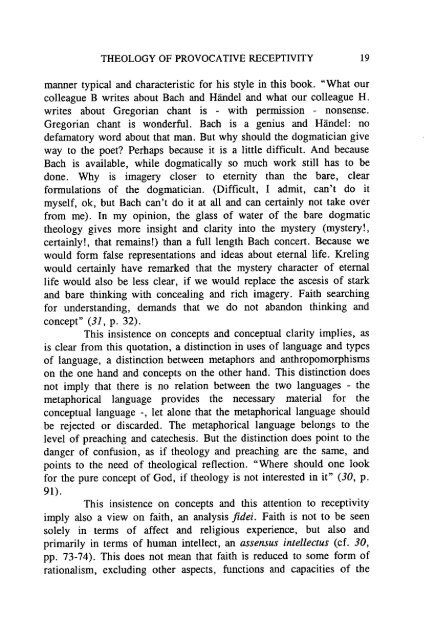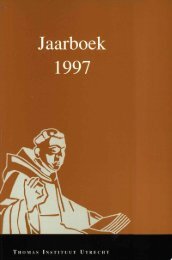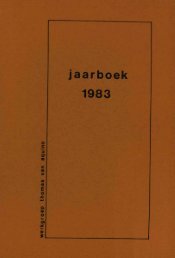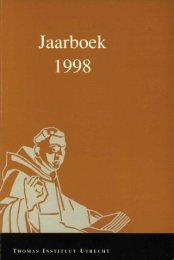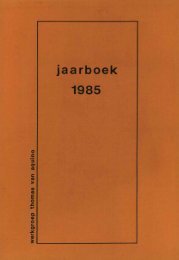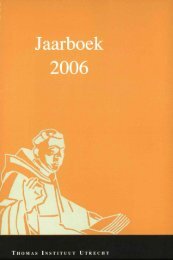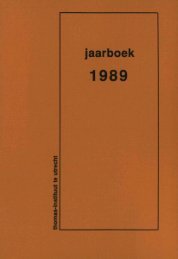Jaarboek Thomas Instituut 1995 - Thomas Instituut te Utrecht
Jaarboek Thomas Instituut 1995 - Thomas Instituut te Utrecht
Jaarboek Thomas Instituut 1995 - Thomas Instituut te Utrecht
You also want an ePaper? Increase the reach of your titles
YUMPU automatically turns print PDFs into web optimized ePapers that Google loves.
THEOLOGY OF PROVOCATIVE RECEPTIVITY 19<br />
manner typical and charac<strong>te</strong>ristic for his style in this book. "What our<br />
colleague B wri<strong>te</strong>s about Bach and Händel and what our colleague H.<br />
wri<strong>te</strong>s about Gregorian chant is - with permission - nonsense.<br />
Gregorian chant is wonderful. Bach is a genius and Händel: no<br />
defamatory word about that man. But why should the dogmatician give<br />
way to the poet? Perhaps because it is a little difficult. And because<br />
Bach is available, while dogmatically so much work still has to be<br />
done. Why is imagery closer to e<strong>te</strong>rnity than the bare, clear<br />
formulations of the dogmatician. (Difficult, I admit, can't do it<br />
myself, ok, but Bach can't do it at all and can certainly not take over<br />
from me). In my opinion, the glass of wa<strong>te</strong>r of the bare dogmatic<br />
theology gives more insight and clarity into the mys<strong>te</strong>ry (mys<strong>te</strong>ry!,<br />
certainly!, that remains!) than a full length Bach concert. Because we<br />
would form false representations and ideas about e<strong>te</strong>rnal life. Kreling<br />
would certainly have remarked that the mys<strong>te</strong>ry charac<strong>te</strong>r of e<strong>te</strong>rnal<br />
life would also be less clear, if we would replace the ascesis of stark<br />
and bare thinking with concealing and rich imagery. Faith searching<br />
for understanding, demands that we do not abandon thinking and<br />
concept" (31, p. 32).<br />
This insis<strong>te</strong>nce on concepts and conceptual clarity implies, as<br />
is clear from this quotation, a distinction in uses of language and types<br />
of language, a distinction between metaphors and anthropomorphisms<br />
on the one hand and concepts on the other hand. This distinction does<br />
not imply that there is no relation between the two languages - the<br />
metaphorical language provides the necessary ma<strong>te</strong>rial for the<br />
conceptual language -, let alone that the metaphorical language should<br />
be rejec<strong>te</strong>d or discarded. The metaphorical language belongs to the<br />
level of preaching and ca<strong>te</strong>chesis. But the distinction does point to the<br />
danger of confusion, as if theology and preaching are the same, and<br />
points to the need of theological reflection. "Where should one look<br />
for the pure concept of God, if theology is not in<strong>te</strong>res<strong>te</strong>d in it" (30, p.<br />
91).<br />
This insis<strong>te</strong>nce on concepts and this at<strong>te</strong>ntion to receptivity<br />
imply also a view on faith, an analysis fidei. Faith is not to be seen<br />
solely in <strong>te</strong>rms of affect and religious experience, but also and<br />
primarily in <strong>te</strong>rms of human in<strong>te</strong>llect, an assensus in<strong>te</strong>llectus (cf. 30,<br />
pp. 73-74). This does not mean that faith is reduced to some form of<br />
rationalism, excluding other aspects, functions and capacities of the


